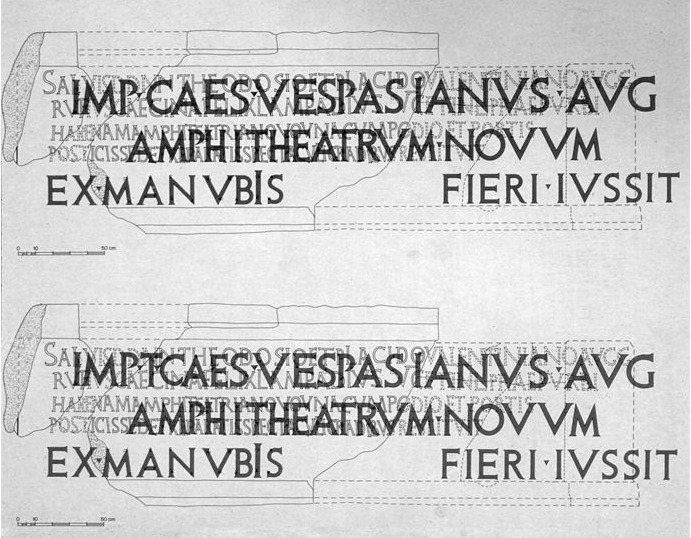Inscriptions
Like many of the other Roman monuments on this site, the Colosseum originally had a dedicatory inscription. Unfortunately, only "an abbreviated version of the amphitheater's large inaugural epigraph, which is now entirely lost" survives today.1 The dedicatory inscription that we have today was found beneath a 5th-6th century CE carving commemorating the restoration of the Colosseum. The original inscription read:
"Imp. Caes. Vespasianus. Aug.
Amphitheatrum Novum
Ex Manubis Fieri Iussit"2
Which translates to "Emperor Caesar Vespasian Augustus ordered a new amphitheatre to be made from spoils". What is quite interesting about this inscription, however, is that it appears to have been slightly modified to read as:
"Imp.T.Caes.Vespasianus Aug.
Amphitheatrum Novum
Ex Manubis Fieri Iussit"3
The inclusion of one letter, "T", changes the meaning of the entire inscription, giving credit for the amphitheatre's construction to Titus, rather than to his father, who died before its completion.
There were, however, other inscriptions on this same block of marble, dating much later. There are, in fact, several restoration inscriptions that can be found throughout the Colosseum. This includes an epigraph that ran "all the way around the amphitheatre" in a place highly visible for all spectators, commemorating restorations after Alaricus' sack of the city in 410 CE.4 There are also inscriptions recognizing the post-earthquake restorations of the Colosseum in the 5th century CE.
Aside from these commemorative inscriptions, many other inscriptions were practical, such as those which identified the various cavea (the stands) sections.5 These inscriptions could be quite specific, like the one that designates the exact seating section for the Fratres Arvales (a religious order) within the cavea.6 Social or professional groups would have a section delineated with an inscription, as would some individuals.7 Inscription, whether intentionally commemorative or not, allow modern archaeologists and historians a window into the social space of the Colosseum.
_____________________________
1 Filippo Coarelli, The Colosseum (Los Angeles: J Paul Getty Museum, 2001), 164.
2 Coarelli, The Colosseum, 165.
3 Coarelli, The Colosseum, 164-65.
4 Coarelli, The Colosseum, 182.
5 Coarelli, The Colosseum, 128.
6 Coarelli, The Colosseum, 128.
7 Coarelli, The Colosseum, 105.
